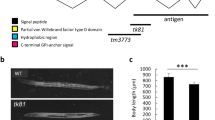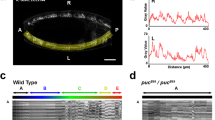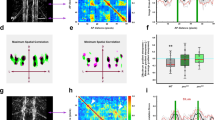Abstract
Growth, guidance and branching of axons are all essential processes for the precise wiring of the nervous system. Rho family GTPases transduce extracellular signals to regulate the actin cytoskeleton1. In particular, Rac has been implicated in axon growth and guidance2,3,4,5,6,7,8. Here we analyse the loss-of-function phenotypes of three Rac GTPases in Drosophila mushroom body neurons. We show that progressive loss of combined Rac1, Rac2 and Mtl activity leads first to defects in axon branching, then guidance, and finally growth. Expression of a Rac1 effector domain mutant that does not bind Pak rescues growth, partially rescues guidance, but does not rescue branching defects of Rac mutant neurons. Mosaic analysis reveals both cell autonomous and non-autonomous functions for Rac GTPases, the latter manifesting itself as a strong community effect in axon guidance and branching. These results demonstrate the central role of Rac GTPases in multiple aspects of axon development in vivo, and suggest that axon growth, guidance and branching could be controlled by differential activation of Rac signalling pathways.
This is a preview of subscription content, access via your institution
Access options
Subscribe to this journal
Receive 51 print issues and online access
$199.00 per year
only $3.90 per issue
Buy this article
- Purchase on Springer Link
- Instant access to full article PDF
Prices may be subject to local taxes which are calculated during checkout




Similar content being viewed by others
References
Hall, A. Rho GTPases and the actin cytoskeleton. Science 279, 509–514 (1998).
Luo, L., Liao, Y. J., Jan, L. Y. & Jan, Y. N. Distinct morphogenetic functions of similar small GTPases: Drosophila Drac1 is involved in axonal outgrowth and myoblast fusion. Genes Dev. 8, 1787–1802 (1994).
Kozma, R., Sarner, S., Ahmed, S. & Lim, L. Rho family GTPases and neuronal growth cone remodelling: relationships between increased complexity induced by Cdc42Hs, Rac1, and acetylcholine and collapse induced by RhoA and lysophosphatidic acid. Mol. Cell. Biol. 17, 1201–1211 (1997).
Zipkin, I. D., Kindt, R. M. & Kenyon, C. J. Role of a new Rho family member in cell migration and axon guidance in C. elegans. Cell 90, 883–894 (1997).
Kaufmann, N., Wills, Z. P. & Van Vactor, D. Drosophila Rac1 controls motor axon guidance. Development 125, 453–461 (1998).
Luo, L. Rho GTPases in neuronal morphogenesis. Nature Rev. Neurosci. 1, 173–180 (2000).
Dickson, B. J. Rho GTPases in growth cone guidance. Curr. Opin. Neurobiol. 11, 103–110 (2001).
Lundquist, E. A., Reddien, P. W., Hartwieg, E., Horvitz, H. R. & Bargmann, C. I. Three C. elegans Rac proteins and several alternative Rac regulators control axon guidance, cell migration and apoptotic cell phagocytosis. Development 128, 4475–4488 (2001).
Hariharan, I. K. et al. Characterization of rho GTPase family homologues in Drosophila melanogaster: overexpressing Rho1 in retinal cells causes a late developmental defect. EMBO J. 14, 292–302 (1995).
Harden, N., Loh, H. Y., Chia, W. & Lim, L. A dominant inhibitory version of the small GTP-binding protein Rac disrupts cytoskeletal structures and inhibits developmental cell shape changes in Drosophila. Development 121, 903–914 (1995).
Newsome, T. et al. Trio combines with dock to regulate Pak activity during photoreceptor axon pathfinding in Drosophila. Cell 101, 283–294 (2000).
Hakeda-Suzuki, S. et al. Rac function and regulation during Drosophila development. Nature 416, 438–442 (2002).
Bourne, H. R., Sanders, D. A. & McCormick, F. The GTPase superfamily: conserved structure and molecular mechanism. Nature 349, 117–127 (1991).
Worthylate, D. K., Rossman, K. L. & Sondek, J. Crystal structure of Rac1 in complex with the guanine nucleotide exchange region of Tiam1. Nature 408, 682–688 (2000).
Mosteller, R. D., Han, J. & Broek, D. Identification of residues of the H-ras protein critical for functional interaction with guanine nucleotide exchange factors. Mol. Cell Biol. 14, 1104–1112 (1994).
Lee, T., Lee, A. & Luo, L. Development of the Drosophila mushroom bodies: sequential generation of three distinct types of neurons from a neuroblast. Development 126, 4065–4076 (1999).
Ito, K., Awano, W., Suzuki, K., Hiromi, Y. & Yamamoto, D. The Drosophila mushroom body is a quadruple structure of clonal units each of which contains a virtually identical set of neurons and glial cells. Development 124, 761–771 (1997).
Lee, T. & Luo, L. Mosaic analysis with a repressible cell marker for studies of gene function in neuronal morphogenesis. Neuron 22, 451–461 (1999).
Lamarche, N. et al. Rac and Cdc42 induce actin polymerization and G1 cell cycle progression independently of p65PAK and the JNK/SAPK MAP kinase cascade. Cell 87, 519–529 (1996).
Joneson, T., McDonough, M., Bar-Sagi, D. & Van Aelst, L. RAC regulation of actin polymerization and proliferation by a pathway distinct from Jun kinase. Science 274, 1374–1376 (1996).
Morreale, A. et al. Structure of Cdc42 bound to the GTPase binding domain of PAK. Nature Struct. Biol. 7, 384–388 (2000).
Owen, D., Mott, H. R., Laue, E. D. & Lowe, P. N. Residues in Cdc42 that specify binding to individual CRIB effector proteins. Biochemistry 39, 1243–1250 (2000).
Hing, H., Xiao, J., Harden, N., Lim, L. & Zipursky, S. Pak functions downstream of Dock to regulate photoreceptor axon guidance in Drosophila. Cell 97, 853–863 (1999).
Yamada, K. M., Spooner, B. S. & Wessells, N. K. Axon growth: roles of microfilaments and microtubules. Proc. Natl Acad. Sci. USA 66, 1206–1212 (1970).
Marsh, L. & Letourneau, P. C. Growth of neurites without filopodial or lamellipodial activity in the presence of cytochalasin B. J. Cell. Biol. 99, 2041–2047 (1984).
Bentley, D. & Toroian-Raymond, A. Disoriented pathfinding by pioneer neurone growth cones deprived of filopodia by cytochalasin treatment. Nature 323, 712–715 (1986).
Scott, E. K. & Luo, L. How do dendrites take their shape? Nature Neurosci. 4, 359–365 (2001).
Wang, K. H. et al. Biochemical purification of a mammalian slit protein as a positive regulator of sensory axon elongation and branching. Cell 96, 771–784 (1999).
Knaus, U. G., Heyworth, P. G., Kinsella, B. T., Curnutte, J. T. & Bokoch, G. M. Purification and characterization of Rac2. J. Biol. Chem. 267, 23575–23582 (1992).
Ito, K. & Hotta, Y. Proliferation pattern of postembryonic neuroblasts in the brain of Drosophila melanogaster. Dev. Biol. 149, 134–148 (1992).
Acknowledgements
We thank the Berkeley Drosophila Genome Project for providing the P-elements, C. Goodman for the FasII antibody, and members of the Luo laboratory and M. Tessier-Lavigne for critical reading of the manuscript. J. N. was partly supported by a postdoctoral fellowship from the American Cancer Society California Division. This research was supported by grants from the National Institutes of Health to L.L., and from the Human Frontiers Science Program to L.L. and B.J.D.
Author information
Authors and Affiliations
Corresponding author
Ethics declarations
Competing interests
The authors declare that they have no competing financial interests
Rights and permissions
About this article
Cite this article
Ng, J., Nardine, T., Harms, M. et al. Rac GTPases control axon growth, guidance and branching. Nature 416, 442–447 (2002). https://doi.org/10.1038/416442a
Received:
Accepted:
Issue Date:
DOI: https://doi.org/10.1038/416442a
This article is cited by
-
Lipophorin receptors regulate mushroom body development and complex behaviors in Drosophila
BMC Biology (2022)
-
Untangling the wires: development of sparse, distributed connectivity in the mushroom body calyx
Cell and Tissue Research (2021)
-
Osteopontin counters human immunodeficiency virus type 1–induced impairment of neurite growth through mammalian target of rapamycin and beta-integrin signaling pathways
Journal of NeuroVirology (2019)
-
Protective Effect of Quercetin in LPS-Induced Murine Acute Lung Injury Mediated by cAMP-Epac Pathway
Inflammation (2018)
-
The ERM protein Moesin is essential for neuronal morphogenesis and long-term memory in Drosophila
Molecular Brain (2017)
Comments
By submitting a comment you agree to abide by our Terms and Community Guidelines. If you find something abusive or that does not comply with our terms or guidelines please flag it as inappropriate.



